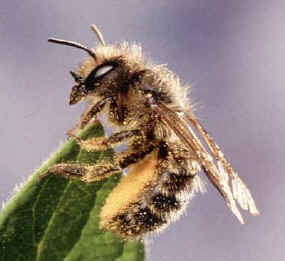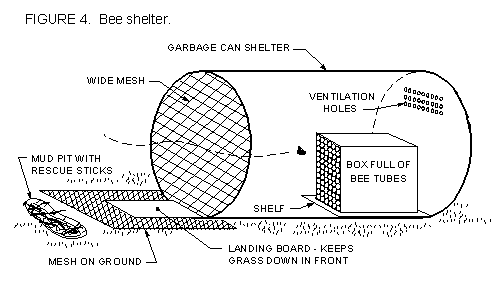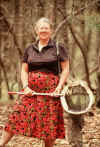![]()
Pollinator Paradise Pollination
Ecology at UI The
Solitary Bee Web
Rearing Solitary Bees
Suppliers References
Bee Gardens FAQ
Links Contact
Us
New Mexico Native Bee Pollinator Project About
Dr. Strickler
Bee Nests and Accessories Bee Photo
Gallery
![]()
Table of ContentsIntroduction Interested in purchasing hornfaced bees? Pollinator Paradise has some for sale (Spring 2007). Click here. Hornfaced Bee, Osmia cornifrons. |
 |
|
|
Hornfaced bees (Osmia cornifrons) have been used to pollinate Japanese orchards for about 60 years, and their popularity is increasing rapidly. They replace honey bees as orchard pollinators because they are so efficient and easy to keep. Only 300 to 400 female hornfaced bees per acre of orchard are needed. Hornfaced bees are a species of mason bee (Osmia). You can keep them together with orchard mason bees (O. lignaria), other native bees, and honey bees. Hornfaced bees are gentle, and thus they are suitable for home gardens and nature study programs in addition to their use as orchard pollinators.
Hornfaced bees are not attacked by the mites and diseases that trouble honey bees, they don't store honey, and they cannot breed with Africanized ("killer") honey bees. They are solitary bees. Instead of having queens and workers, each female hornfaced bee mates, makes her own nest cells of mud, collects nectar and pollen for bee-bread, and lays eggs. Hornfaced bees are gregarious, preferring to make their nests in the vicinity of other hornfaced bees. Unlike honey bee drones, male hornfaced bees visit flowers, contributing to pollination.
Hornfaced bees have only one generation per year (see diagram). Adult bees are active for four to six weeks each spring when orchards bloom then, they all die. The rest of the year, hornfaced bees exist only as dormant brood and young bees inside nest cells. This means that the bees can be removed from the orchard after pollination and stored for the 10 months when they are not needed. You may expect a three to five-fold increase in population yearly, if the bees have plenty of food and nest materials and are protected from pesticides, pests, and predators.
During your first year with hornfaced bees, keep them in a safe, pesticide-free place such as your home garden where you can easily watch them to learn about their habits. They will feed at blossoms of crabapples, cherries, bush honeysuckles and many other spring-blooming ornamental plants. The next year, you can begin placing the surplus bees that you raised in orchards for pollination. You should always keep some of your bees in a secure place for breeding more pollinator bees in future years.
Winter: The bees exist as young adults hibernating inside brown cocoons (Figures 1 and 2). They require some freezing to break dormancy and can tolerate temperatures as low as 10 degrees F. The bees emerge from cocoons and nests after several days when warmed. Usually, hornfaced bees are shipped in late winter, near the end of their hibernation period, and are ready to go outdoors.
Spring: When the bees are put outside and exposed to your local early spring weather for a few weeks, they usually begin emerging from nests at about the time when the first crocuses, forsythia and red maples bloom. Here in Maryland, I know that they will emerge when the cherry trees in Washington, D.C. start to bloom. Male bees (small, with long antennae) start to emerge a few days before females (large, with horns). They mate near the nests: the male performs a courtship ritual, with much buzzing and tapping on the female. After a few days, the females begin to make nests and pollinate. If you need to apply pesticides, do so in the evening or during very cold, cloudy days when bees stay inside the nests, and temporarily cover the nests. Once the bees have started nesting, do not move the nests or the bees will become disoriented and lost.
Summer: By late spring when the trees have leafed out, the adult bees are dying of old age. You can see that their fuzz has worn off, their wings are tattered, and they fly slowly. At this time it is important to gently move the nests out of the orchard and put them away in an unheated, dry storage place for the rest of the year. This will protect the helpless baby bees (larvae) inside the nests from attacks by parasites and predators. The most damaging parasites are tiny, black Monodontomerus wasps which drill into nests and attack many kinds of solitary bees. They start to appear in early summer and continue to attack bee broods all summer. Birds and animals such as woodpeckers, squirrels, raccoons, mice, and rats also can destroy nests and eat developing bees.
Fall: The larvae in nest cells have finished eating the stored bee-bread. They spin cocoons, turn into pupae and become dormant as new adult bees ready to begin hibernation. Hornfaced bees need some freezing to break dormancy, but not too much; they do best in a humid, temperate climate in USDA Plant Hardiness Zones 5 - 8
Hornfaced bees need smooth-walled holes to build their nest cells inside. These holes should be 5/16" in width and 4 to 10 inches deep. The end of the hole must be blind (sealed), so that parasites cannot get to the cells. In nature, wild hornfaced bees make their nests in hollow reeds, bamboo sections, and beetle holes in wood. When the holes are 5/16" wide, many female bees are produced. If the hole is narrower, more of the smaller male bees are produced. The nesting mother bees can adjust the sex of their eggs according to the size of the hole. Thus, the 5/16" hole produces the most valuable female bees. You can cut sections of common reeds, canes or bamboo, which are tough and waterproof (Figure 2). If these are not available, or you can use cardboard tubes (plain, .040 wall thickness, 5/16" x 16" bent-in-half, bundled, available from Custom Paper Tubes, Inc., 4832 Ridge Road, Cleveland, Ohio 44144 - 0187; Tel. (216)-741-0378. Plastic soda straws are not good because they hold moisture, which causes the bee-bread to rot. Paper straws are too flimsy.
Wooden blocks that are drilled with 5/16" holes to accommodate orchard mason bees (Figure 3) are now available from several sources. Hornfaced bees will also use these. The drilled wooden blocks have the advantage of superior strength and permanence (bees will re-use the holes); however, they are bulky, heavy, and do not hold as many nesting bees per unit volume as do the tubular materials. You can make your own bee blocks by drilling smooth-walled, 5/16" x 4 - 8" holes in dry, seasoned, untreated, non-splitting posts, beams, or logs (use a brad-point drill bit for best results).
More information on making a nesting block for Osmia from the USDA/ARS Bee Lab, Logan, UT.
Nesting materials must be kept dry so that the bee-bread won't spoil, poisoning the larvae. Holes in tubular materials and blocks should be kept horizontal, and the nest entrances should face south to east for warmth and light on cool spring days. Bee blocks and bundled tubes can be put on a shelf or securely attached to the south sides of buildings that have wide enough eaves to keep rain away. Or, they can be attached beneath dry portions of decks well above ground level, under open garage roofs, and in openings of barns and sheds.
Free-standing bee shelters are used where no suitable buildings are near orchards. Because hornfaced bees usually fly up to 100 yards, small, south-facing shelters can be placed every 200 yards around the borders of the orchard. If the orchard is very large, some shelters must be placed inside it for uniform pollination. Many items can be used for temporary or permanent bee shelters. Some of them are dog houses and calf hutches, A-frame and lean-to structures, clean oil drums or large garbage cans on cement blocks, sewer pipe sections, and plastic tarps tied to frames (Figure 4). Shelters should be of a light color but not shiny metal, and should have some cross-ventilation to prevent overheating on hot, sunny days.

A foot-deep pit with pesticide-free, damp, clay soil or mud should be dug near each shelter. The bees will collect this soil to make their brood cells. A few twigs in the pit will provide "life preservers" to prevent falling bees from drowning when pits become puddles after rains. If birds attack, put mesh with 2" holes over the pits.
Because hornfaced bees have only a mild sting (like a mosquito bite), they are likely to be eaten by birds (mostly catbirds) and animals. Females are vulnerable at nests when slowly flying with loads of mud and pollen, when sealing their nests, and while mating. You should put a screen of plastic mesh or chicken wire with at least 2" wide holes in front of each shelter (Figure 4). The bees can fly through 2" holes without breaking their wings. The screen should be about 2-3 feet away from the nesting materials so that the flying bees can easily see it and have enough space to turn in flight in order to go through the holes cleanly. If animals are a problem, more mesh can be placed flat on the ground in front of bee shelters. It will tangle the animals' feet, discouraging them from approaching the bees' nests. Reflective Mylar bird-scaring tape near shelters helps to keep birds away.
You should promptly remove your bees from the outdoors in late spring and put them into an unheated building, one that won't overheat in midsummer. If you expect intense winter cold snaps, you can insulate the stored bees with bales of hay or other materials, or temporarily put them in a refrigerator, humidified with moist sponges. I store hornfaced bees in an insulated masonry building that fluctuates between 10 degrees F in winter and 85 degrees in summer. Outdoor temperatures fluctuate from 0 degrees in the winter to over 100 degrees in the summer.
Because the time needed for development from egg to adult is long (6 months), people who want to try hornfaced bees in areas colder than Plant Hardiness Zone 5 can help their bees by bringing them in to a sheltered area such as a glassed-in porch before the first frost. Bees should be held at 50 to 60 degrees until the end of November, and then be allowed to cool further. Bees should not be allowed to cool much below 10 degrees Fahrenheit.
When removing your bees from outdoors, handle the nest materials gently in order to prevent harm to delicate eggs and larvae. Keep the nests in a horizontal position, as they were outdoors. If there are still a few old females flying around the shelters, you can leave some empty nest materials out for them. If you need to use pesticides or perform other operations right after petal-fall, you can move the bees nests to storage early. This will cause the loss of some old adult bees, but if they have had plenty of food, there should have been enough reproduction. Hornfaced bees should be protected from rats and mice during storage. Nests with dormant bees can be kept in covered garbage cans or other rat-proof containers in a dry place. Small holes for ventilation are needed.
The time of emergence of hornfaced bees can be delayed for several weeks in spring, if they are needed to pollinate late-spring to early-summer flowers or for use in greenhouses. For this, dormant bees should be taken from storage before they would naturally emerge, and held under refrigeration at 35 - 40 degrees F (just above freezing) with ample (over 75 percent) air humidity maintained by moist sponges near the nests. The hibernating bees will become active after a few days of warmth. Holding bees under refrigeration all winter is not recommended, because it is difficult to maintain the high humidity needed to prevent desiccation and death.
To prevent the buildup of pests and diseases over the years, the bees should be encouraged to move into new nest materials every two or three years. The old nest materials can then be removed for sterilization (bake or microwave) or destruction (burn or bury). To make the bees abandon their old nests (which they prefer to reuse), it is necessary to conceal the old nests while the bees are emerging for the first time in early spring, meanwhile placing new (or sterilized) nest materials in full view of the bees (Figure 5). During their very first flight, young bees memorize the place that they flew from (zigzag orientation flight). If the first thing they see is new nest material, they will return to it. The old materials can easily be concealed in a black plastic garbage bag with just a small hole to let bees out (and air in). After a few days, when bees are using the new nest material, the bag full of old nests can be removed (see picture). The bags can be kept several yards away from the bee shelter for a few days to let any accidentally captured bees escape before sterilizing or destroying old nest materials.
Keep notes on the bees' activities for better management and busier bees in future years. Please write to me and tell me how they succeed in your area. Suggestions are welcome!
This tiny, gnat sized, black wasp parasitizes several kinds of solitary bees in North America and Europe, including leafcutter bees and mason bees. In Maryland, these wasps start to attack hornfaced bees in mid-to-late May. Thus, it is important to protect your bees from wasp attacks toward the end of the bees' seasonal period of adult activity. This can easily be done by removing the bees from the field and promptly putting them into storage, or by securely screening your bee shelters at that time with a fine-meshed metal, fiberglass, or nylon screen that the tiny wasps cannot squeeze through. Each female wasp can lay about ten eggs in each hornfaced bee as it develops in its brood cell. The wasp eggs produce mostly female wasps. Thus, the potential for multiplication of wasps and destruction of bees is great. These wasps have two generations per year, which makes it possible to control them when they attack hornfaced bees. The first generation of wasps appears in late May and the second generation appears in July. I control wasps in Beltsville by the following simple method:
Remove bees from the field to the storage shed, barn, etc., in late May. The bees (developing brood in tubes) are put in large cardboard boxes (or garbage cans, if mice are a problem) with only a slit left open for wasps to emerge through (the July brood). When in storage containers, tubes should be laid horizontally, as they were in the field. The boxes with bee tubes are then put on shelves in a dark storage shed that has only one window (facing south). Ordinary fly paper is hung inside the window to trap wasps, which come to the light from the window in July. Most wasps do not find their way back to the bee tubes in the dark boxes. They get stuck on the fly paper or die of starvation. By this simple, easy method, I have been able to maintain hornfaced bees for about 15 years with less than 1 percent parasitization.
I keep poison bait and traps in the storage shed for mouse control during the bees' long dormant period. If many mice and rats attack your dormant bees, you could keep the bee tubes in mouse-proof containers, such as garbage cans, with small holes for ventilation.
|
Dr. Suzanne Batra Interested in purchasing hornfaced bees? Pollinator Paradise sells them. Click here. |
 |
![]()
Top of Page Pollinator Paradise Pollination
Ecology at UI The
Solitary Bee Web
Rearing Solitary Bees
Suppliers References
Bee Gardens FAQ
Links Contact
Us
New Mexico Native Bee Pollinator Project About
Dr. Strickler
Bee Nests and Accessories Bee Photo
Gallery
![]()